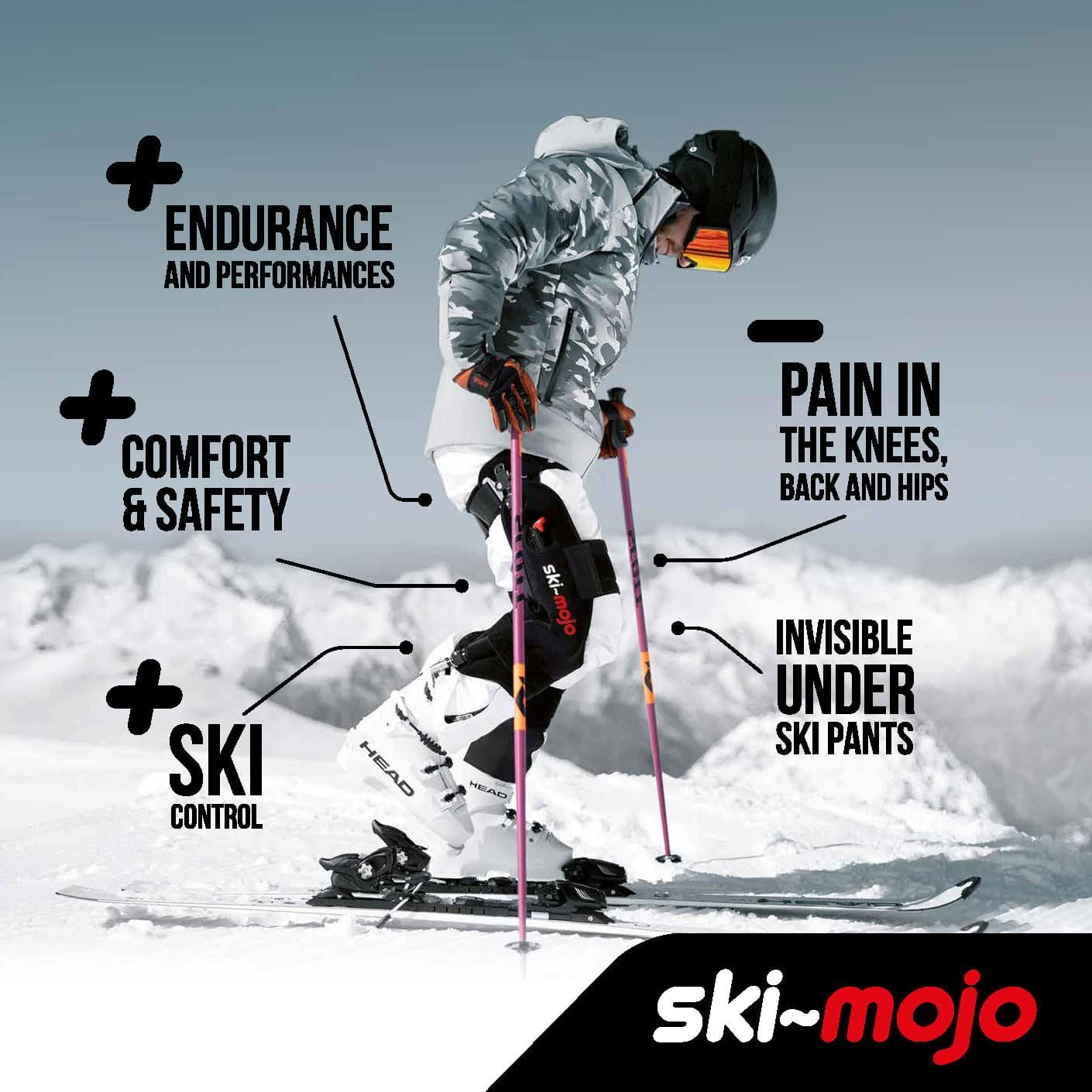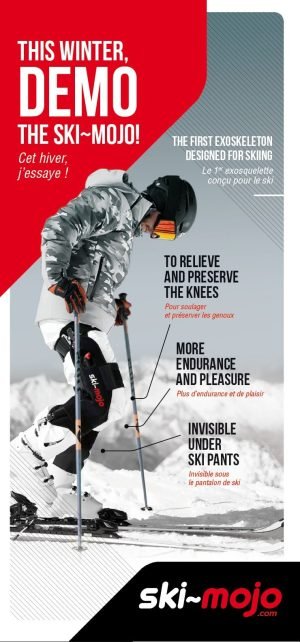Skiing places high demands on the lower-limb joints, especially the knees: impacts, rotation and prolonged flexion can worsen pre-existing pain or lead to new injuries. In this context, healthcare professionals play a key role in preparing, supporting and advising their skiing patients. Among available solutions, Ski-Mojo directly addresses the causes of pain and helps reduce injury risk—an innovative ally to lower joint loading and extend enjoyment on the slopes.
Pre-season assessment and risk screening
A targeted functional assessment before the season helps identify:
- Muscle weaknesses (quadriceps, hamstrings, glutes).
- Deficits in proprioception and balance.
- Trauma history (ACL, meniscus) or osteoarthritis.
This guides a personalised programme: strength training, posture work, core stability and proprioceptive exercises.
Choosing appropriate equipment
Equipment choice directly influences knee loading. Pay attention to:
- Accurate binding settings.
- Comfortable, well-fitted boots.
- Optional custom insoles.
- Avoid overly wide waist skis: beyond 90 mm, the lever arm increases knee torque, especially on hard snow. Prefer 70–85 mm for versatile use [ref. 1].
Muscle fatigue: a major risk factor
Towards the end of the day or after several days of skiing, muscle fatigue reduces stability and proprioception [ref. 2] ; [ref. 3]. Quadriceps and stabilising muscles control the knee less effectively, increasing the risk of sprains, meniscal tears or ACL rupture. By delaying the onset of muscle fatigue, Ski-Mojo improves skier safety.
How Ski-Mojo provides technical support to skiers

Ski-Mojo, a mechanical exoskeleton for skiing and snowboarding, transfers roughly one-third of the skier’s bodyweight from the pelvis to the ground. This means 15 to 40 kg less load borne by the legs. Powered by strong springs, it also absorbs shocks and vibrations travelling up the legs. Finally, by improving ski–snow contact, it enhances ski bending for more controlled turns. Learn more about the Ski-Mojo technology by following this link.
Immediate benefits for the skier
- By reducing tibiofemoral and patellofemoral pressures, Ski-Mojo most of the time reduces — and can even eliminate in some cases — knee pain [ref. 4].
- Lower shocks and vibrations also contribute to this reduction in knee pain (reported in over 99% of cases in our user feedback), and also in the hips and the back (in roughly one out of two cases).
- By lightening perceived leg load, Ski-Mojo reduces quadriceps activation while slightly increasing hamstring activation. This rebalancing of thigh muscle work (EMG study 1 ; EMG study 2) tends to protect knee ligaments.
- Finally, carrying less weight on the legs leads to a reduction in muscle fatigue. Your legs stay fresher for longer, allowing you to react quickly if something unexpected occurs.
These benefits are concrete and measured
A medical thesis by Dr Maxence Bory at Claude Bernard University Lyon 1 [ref. 5] provides quantitative evidence of Ski-Mojo’s benefits, based on a sample of mountain professionals:
- Maintaining professional activity: 63% report that Ski-Mojo enabled them to keep working despite their conditions (often knee osteoarthritis). The author describes it as a valuable tool for prolonging careers.
- Reduction in healthcare consumption: 66% reduced painkillers and 60% reduced injections, reflecting a tangible decrease in medical treatments.
- Impact on surgery: 75% believe Ski-Mojo helped postpone surgical procedures (arthroplasty, ACL reconstruction).
- Reduction in absenteeism: over 70% report a reduction—or disappearance—of sick leave related to pain, with direct impact for both the individual and the employer.
Independent medical findings that confirm what thousands of skiers already experience on the slopes.
Guidance for Professionals
- Ski-Mojo can also be used in reconditioning, as with World Cup racer Armand Marchant (read the French article here).
- Like an e-bike, Ski-Mojo is not a medical device, yet it is often recommended preventively for all skiers or as a solution for those already experiencing osteoarthritis or post-traumatic sequelae.
- Ski-Mojo does not provide lateral knee stabilisation. If stabilisation is needed, a brace, even a bulky one, can be worn under Ski-Mojo, as a complement.
Practical advice
- Suggest a specific warm-up before the first run.
- Break sessions into shorter blocks and heed pain signals.
- Combine Ski-Mojo with strength and proprioception exercises.
- Recommend an in-season maintenance routine to preserve gains.
- If lateral stabilisation is required, recommend a brace worn under Ski-Mojo.
Frequently Asked Questions
Should Ski-Mojo be used on both legs?
Yes. Ski-Mojo is designed for bilateral assistance: using it on both legs ensures a symmetrical load distribution, maintains hip–knee–ankle alignment, balances proprioception, and limits compensations in the lumbar spine. This is why the Ski-Mojo pack includes both the right and the left leg.
Does muscle fatigue increase accident risk?
Yes. Fatigue impairs stability and proprioception, increasing the risk of sprains, meniscal injuries or ACL rupture. By delaying the onset of muscle fatigue, Ski-Mojo improves skier safety.
Is Ski-Mojo a medical device?
No. Ski-Mojo is not a medical device. However, many healthcare professionals (especially those who have tried it) often recommend it to prevent or reduce joint and muscle pain and to improve comfort and endurance when skiing.
Can a brace be worn under Ski-Mojo?
Yes, a brace or splint, even a bulky one, can be worn underneath as a complement if lateral stabilisation is required.







